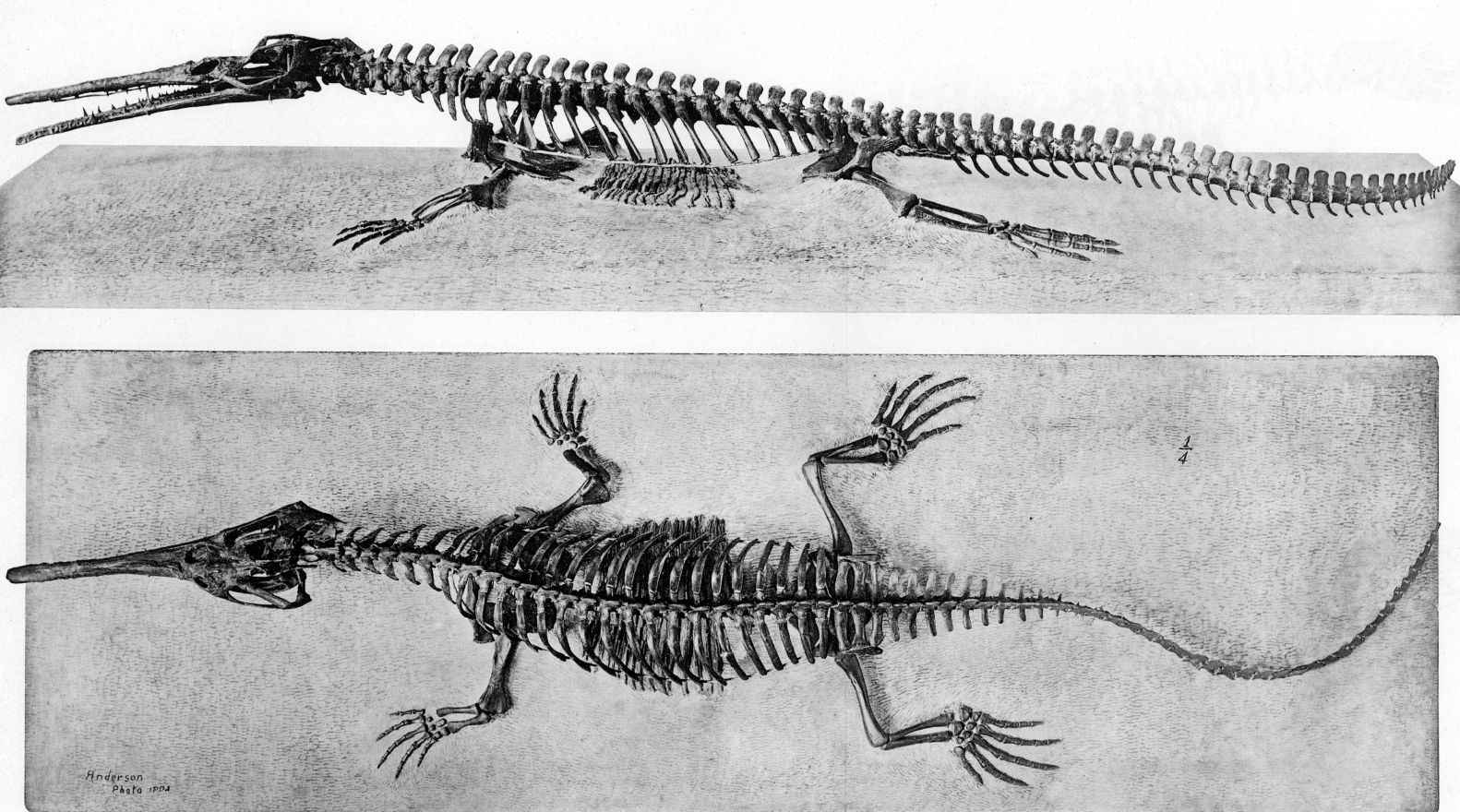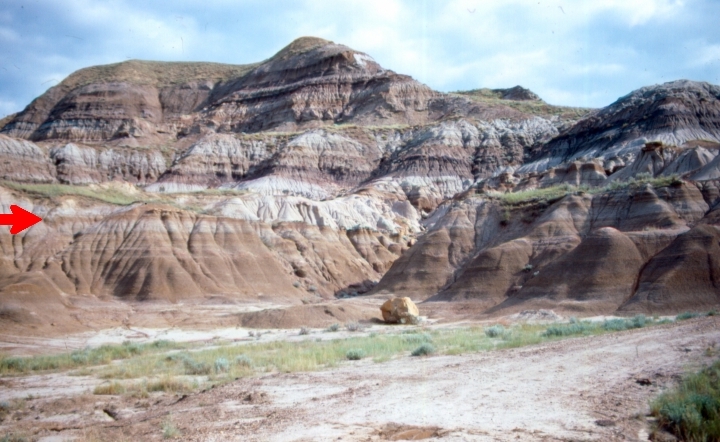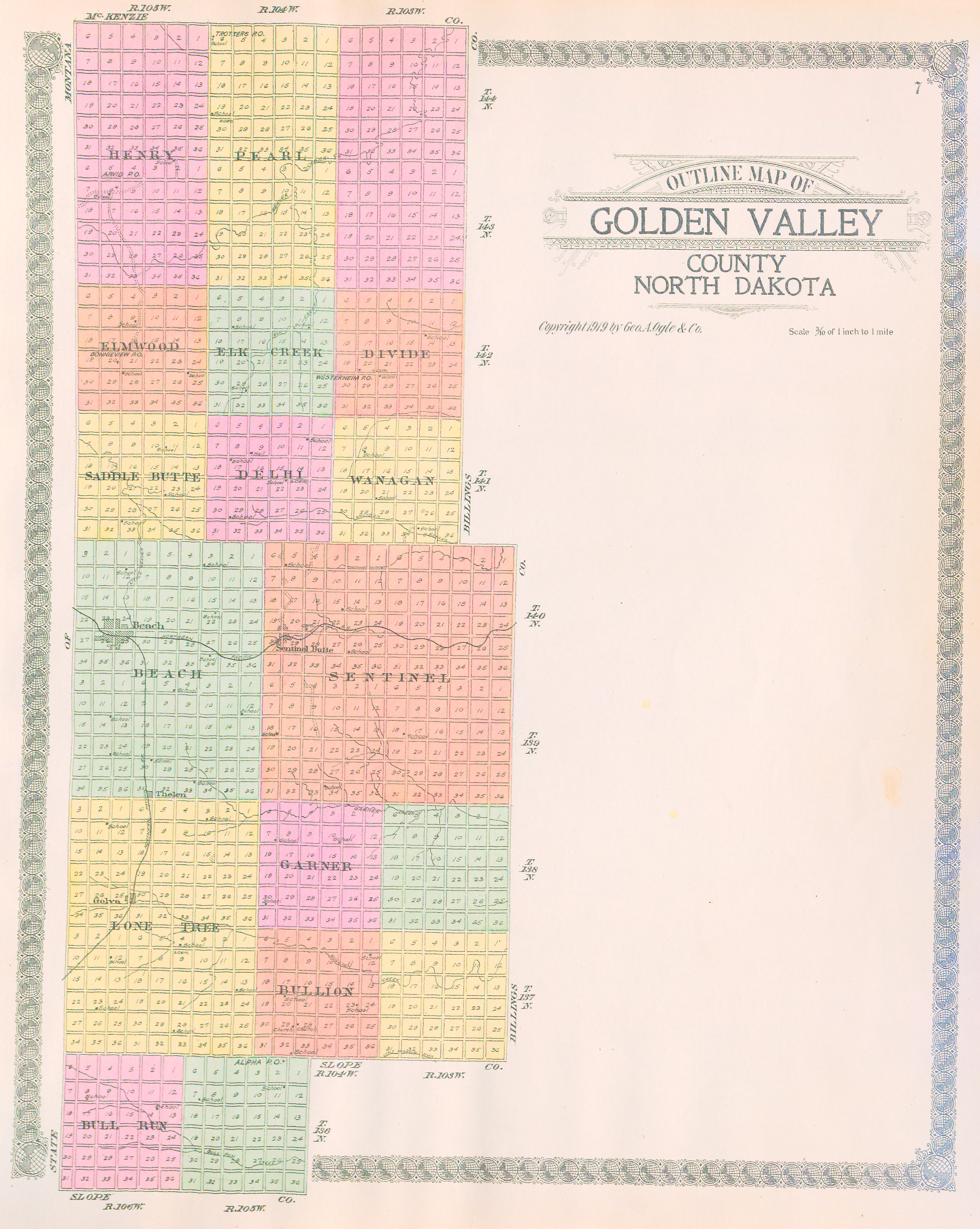|
Champsosaurus
''Champsosaurus'' is an extinct genus of crocodile-like choristodere reptile, known from the Late Cretaceous and early Paleogene periods of North America and Europe (Campanian-Paleocene). The name ''Champsosaurus'' is thought to come from , () said in an Ancient Greek source to be an Egyptian word for "crocodiles", and , () Greek for "lizard". The morphology of ''Champsosaurus'' resembles that of gharials, with a long, elongated snout. It was native to freshwater environments where it likely preyed on fish, similar to living gharials. History of research ''Champsosaurus'' was the first member of the Choristodera to be described. ''Champsosaurus'' was named by Edward Drinker Cope in 1876, from isolated vertebrae found in Late Cretaceous strata of the Judith River Formation on the banks of the Judith River in Fergus County, Montana. Cope designated ''C. annectens'' as the type species rather than the first named ''C. profundus'' due to the larger number of vertebrae he attributed t ... [...More Info...] [...Related Items...] OR: [Wikipedia] [Google] [Baidu] |
Choristodera
Choristodera (from the Greek χωριστός ''chōristos'' + δέρη ''dérē'', 'separated neck') is an extinct order of semiaquatic diapsid reptiles that ranged from the Middle Jurassic, or possibly Triassic, to the late Miocene (168 to 11.6 million years ago). Choristoderes are morphologically diverse, with the best known members being the crocodile-like neochoristoderes such as ''Champsosaurus''. Other choristoderans had lizard-like or long necked morphologies. Choristoderes appear to have been confined to the Northern Hemisphere, having been found in North America, Asia, and Europe, and possibly also North Africa. Choristoderes are generally thought to be derived neodiapsids that are close relatives or members of Sauria. History of Discovery Choristodera was erected in 1876, originally as a suborder of Rhynchocephalia by Edward Drinker Cope to contain ''Champsosaurus,'' which was described from Late Cretaceous strata of Montana by Cope in the same paper. A year late ... [...More Info...] [...Related Items...] OR: [Wikipedia] [Google] [Baidu] |
Horseshoe Canyon Formation
The Horseshoe Canyon Formation is a stratigraphic unit of the Western Canada Sedimentary Basin in southwestern Alberta. It takes its name from Horseshoe Canyon, an area of badlands near Drumheller. The Horseshoe Canyon Formation is part of the Edmonton Group and is up to thick. It is of Late Cretaceous age, Campanian to early Maastrichtian stage (Edmontonian Land-Mammal Age), and is composed of mudstone, sandstone, carbonaceous shales, and coal seams. A variety of depositional environments are represented in the succession, including floodplains, estuarine channels, and coal swamps, which have yielded a diversity of fossil material. Tidally-influenced estuarine point bar deposits are easily recognizable as Inclined Heterolithic Stratification (IHS). Brackish-water trace fossil assemblages occur within these bar deposits and demonstrate periodic incursion of marine waters into the estuaries. The Horseshoe Canyon Formation crops out extensively in the area around Drumheller, a ... [...More Info...] [...Related Items...] OR: [Wikipedia] [Google] [Baidu] |
Judith River Formation
The Judith River Formation is a fossil-bearing geologic formation in Montana, and is part of the Judith River Group. It dates to the Late Cretaceous, between 79 and 75.3 million years ago, corresponding to the "Judithian" land vertebrate age. It was laid down during the same time period as portions of the Two Medicine Formation of MontanaSullivan, R.M. and Lucas, S. G. (2006). "The Kirtlandian land-vertebrate "age"–faunal composition, temporal position and biostratigraphic correlation in the nonmarine Upper Cretaceous of western North America." Pp. 7-29 in Lucas, S. G. and Sullivan, R.M. (eds.), ''Late Cretaceous vertebrates from the Western Interior. New Mexico Museum of Natural History and Science Bulletin 35''. and the Oldman Formation of Alberta. It is an historically important formation, explored by early American paleontologists such as Edward Drinker Cope, who named several dinosaurs from scrappy remains found here on his 1876 expedition (such as ''Monoclonius''). Modern ... [...More Info...] [...Related Items...] OR: [Wikipedia] [Google] [Baidu] |
Edward Drinker Cope
Edward Drinker Cope (July 28, 1840 – April 12, 1897) was an American zoologist, paleontologist, comparative anatomist, herpetologist, and ichthyologist. Born to a wealthy Quaker family, Cope distinguished himself as a child prodigy interested in science; he published his first scientific paper at the age of 19. Though his father tried to raise Cope as a gentleman farmer, he eventually acquiesced to his son's scientific aspirations. Cope married his cousin and had one child; the family moved from Philadelphia to Haddonfield, New Jersey, although Cope would maintain a residence and museum in Philadelphia in his later years. Cope had little formal scientific training, and he eschewed a teaching position for field work. He made regular trips to the American West, prospecting in the 1870s and 1880s, often as a member of United States Geological Survey teams. A personal feud between Cope and paleontologist Othniel Charles Marsh led to a period of intense fossil-finding competition ... [...More Info...] [...Related Items...] OR: [Wikipedia] [Google] [Baidu] |
Bruce Erickson
Bruce R. Erickson (1933 – January 16, 2022) was an American paleontologist and the former Fitzpatrick Chair of Paleontology at the Science Museum of Minnesota. During the course of his lifetime and his 55 years as a paleontologist, he has "collected about a million specimens" and discovered fifteen new types of plants and ancient animal species. His collection includes "a triceratops skeleton" that he discovered in 1961 at the Hell Creek Formation that is considered to be "one of the rarest in the world".Estrada, Heron Marquez"Book fleshes out a career studying dinosaur bones" Star Tribune, April 27, 2003 His research has focused almost entirely on the Paleocene era in history. Biography According to Erickson, his interest in paleontology began when he was ten years old and he came across a geologist investigating rocks along the bank of the Mississippi River.Brody, Jane E."26 Years Deep in the Paleocene" Los Angeles Times, September 3, 1996 Career In the 1960s, Erickson spent ... [...More Info...] [...Related Items...] OR: [Wikipedia] [Google] [Baidu] |
Paleocene
The Paleocene, ( ) or Palaeocene, is a geological epoch (geology), epoch that lasted from about 66 to 56 mya (unit), million years ago (mya). It is the first epoch of the Paleogene Period (geology), Period in the modern Cenozoic Era (geology), Era. The name is a combination of the Ancient Greek ''palaiós'' meaning "old" and the Eocene Epoch (which succeeds the Paleocene), translating to "the old part of the Eocene". The epoch is bracketed by two major events in Earth's history. The K–Pg extinction event, brought on by Chicxulub impact, an asteroid impact and possibly volcanism, marked the beginning of the Paleocene and killed off 75% of living species, most famously the non-avian dinosaurs. The end of the epoch was marked by the Paleocene–Eocene Thermal Maximum (PETM), which was a major climatic event wherein about 2,500–4,500 gigatons of carbon were released into the atmosphere and ocean systems, causing a spike in global temperatures and ocean acidification. In the Pal ... [...More Info...] [...Related Items...] OR: [Wikipedia] [Google] [Baidu] |
Cretaceous
The Cretaceous ( ) is a geological period that lasted from about 145 to 66 million years ago (Mya). It is the third and final period of the Mesozoic Era, as well as the longest. At around 79 million years, it is the longest geological period of the entire Phanerozoic. The name is derived from the Latin ''creta'', "chalk", which is abundant in the latter half of the period. It is usually abbreviated K, for its German translation ''Kreide''. The Cretaceous was a period with a relatively warm climate, resulting in high eustatic sea levels that created numerous shallow inland seas. These oceans and seas were populated with now- extinct marine reptiles, ammonites, and rudists, while dinosaurs continued to dominate on land. The world was ice free, and forests extended to the poles. During this time, new groups of mammals and birds appeared. During the Early Cretaceous, flowering plants appeared and began to rapidly diversify, becoming the dominant group of plants across the Earth b ... [...More Info...] [...Related Items...] OR: [Wikipedia] [Google] [Baidu] |
Dinosaur Park Formation
The Dinosaur Park Formation is the uppermost member of the Belly River Group (also known as the Judith River Group), a major geologic unit in southern Alberta. It was deposited during the Campanian stage of the Late Cretaceous, between about 76.5 and 74.4 million years ago. It was deposited in alluvial and coastal plain environments, and it is bounded by the nonmarine Oldman Formation below it and the marine Bearpaw Formation above it.Eberth, D.A. 2005. The geology. In: Currie, P.J., and Koppelhus, E.B. (eds), Dinosaur Provincial Park: A Spectacular Ancient Ecosystem Revealed. Indiana University Press: Bloomington and Indianapolis, p.54-82. . The Dinosaur Park Formation contains dense concentrations of dinosaur skeletons, both articulated and disarticulated, which are often found with preserved remains of soft tissues. Remains of other animals such as fish, turtles, and crocodilians, as well as plant remains, are also abundant. The formation has been named after Dinosaur Pr ... [...More Info...] [...Related Items...] OR: [Wikipedia] [Google] [Baidu] |
Bullion Creek Formation
The Bullion Creek Formation is a geologic formation in western North Dakota. It preserves bones and tracks of an extinct crocodile and other fossils of Late Paleocene The Thanetian is, in the International Commission on Stratigraphy, ICS Geologic timescale, the latest age (geology), age or uppermost stage (stratigraphy), stratigraphic stage of the Paleocene epoch (geology), Epoch or series (stratigraphy), Serie ... age.Erickson, B.R., 2005. Crocodile and Arthropod Tracks from the Late Paleocene Wannagan Creek Fauna of North Dakota, USA. Ichnos, 12(4):3 03-308. See also * List of fossiliferous stratigraphic units in North Dakota * Paleontology in North Dakota References Paleogene geology of North Dakota Paleocene Series of North America Thanetian Stage {{Paleogene-stub ... [...More Info...] [...Related Items...] OR: [Wikipedia] [Google] [Baidu] |
Golden Valley County, North Dakota
Golden Valley County is a county in the U.S. state of North Dakota. As of the 2020 census, the population was 1,736,} making it the fourth-least populous county in North Dakota. The county seat is Beach. The county should not be confused with the city of Golden Valley, which is located in Mercer County. History In the general election held November 8, 1910, the voters of Billings County chose to separate the western portion of Billings and form a new county. This result was immediately challenged in court; on September 19, 1912, the ND Supreme Court upheld the election result; therefore the legislature completed the county's organization on November 13, 1912. Golden Valley was called 'Rattlesnake Flats' by early settlers, due to the large number of the snakes found in the area. The region was dubbed Golden Valley in 1902 after a group of land surveyors noticed that the sunlight gave the surrounding grasses a distinct golden color. Retrieved via Ancestry.com. Election contr ... [...More Info...] [...Related Items...] OR: [Wikipedia] [Google] [Baidu] |
Hell Creek Formation
The Hell Creek Formation is an intensively studied division of mostly Upper Cretaceous and some lower Paleocene rocks in North America, named for exposures studied along Hell Creek, near Jordan, Montana. The formation stretches over portions of Montana, North Dakota, South Dakota, and Wyoming. In Montana, the Hell Creek Formation overlies the Fox Hills Formation. The site of Pompeys Pillar National Monument is a small isolated section of the Hell Creek Formation. In 1966, the Hell Creek Fossil Area was designated as a National Natural Landmark by the National Park Service. It is a series of fresh and brackish-water clays, mudstones, and sandstones deposited during the Maastrichtian and Danian (respectively, the end of the Cretaceous period and the beginning of the Paleogene) by fluvial activity in fluctuating river channels and deltas and very occasional peaty swamp deposits along the low-lying eastern continental margin fronting the late Cretaceous Western Interior Seaway. Th ... [...More Info...] [...Related Items...] OR: [Wikipedia] [Google] [Baidu] |
Sentinel Butte Formation
The Sentinel Butte Formation is a geologic formation of Paleocene age in the Williston Basin of western North Dakota. It preserves significant assemblages of non-marine plant and animal fossil A fossil (from Classical Latin , ) is any preserved remains, impression, or trace of any once-living thing from a past geological age. Examples include bones, shells, exoskeletons, stone imprints of animals or microbes, objects preserved ...s. See also * List of fossiliferous stratigraphic units in North Dakota * Paleontology in North Dakota References Paleogene geology of North Dakota Thanetian Stage {{Paleogene-stub ... [...More Info...] [...Related Items...] OR: [Wikipedia] [Google] [Baidu] |









